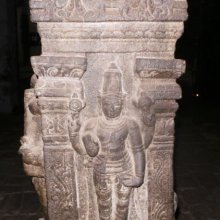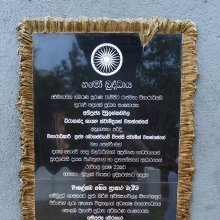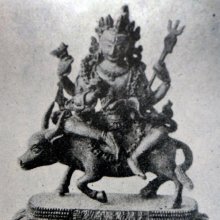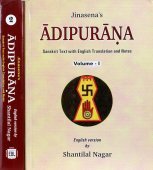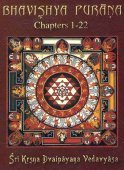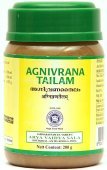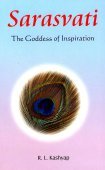Purana, Purāṇa, Pūraṇa, Purāna: 55 definitions
Introduction:
Purana means something in Buddhism, Pali, Hinduism, Sanskrit, Jainism, Prakrit, the history of ancient India, Marathi, Hindi, biology. If you want to know the exact meaning, history, etymology or English translation of this term then check out the descriptions on this page. Add your comment or reference to a book if you want to contribute to this summary article.
Images (photo gallery)
(+13 more images available)
In Hinduism
Ayurveda (science of life)
Source: Wisdom Library: Āyurveda and botanyPurāṇa (पुराण) is a Sanskrit technical term, referring to “old” (e.g. herbs or samples of drugs). The term is used throughout Ayurvedic literature such as the Suśruta-saṃhitā and the Caraka-saṃhitā.
Source: archive.org: Vagbhata’s Ashtanga Hridaya Samhita (first 5 chapters)Purāṇa (पुराण) or Purāṇaghṛta refers to “old ghee”, as mentioned in verse 5.40 of the Aṣṭāṅgahṛdayasaṃhitā (Sūtrasthāna) by Vāgbhaṭa.—Accordingly, “Frenzy, epilepsy, stupor, (and) diseases affecting the head, ears, eyes, and womb destroys old ghee [viz., purāṇaghṛta]; it is purificatory and curative of wounds”.
Note: Purāṇa [purāṇam] (sc. ghṛtam)—“old ghee” has been removed to the head of the stanza and translated by mar rñiṅ; although literally meaning “butter” (see v. 35), mar is often used in the sense of “ghee”, e.g. 1.25, 3.50, 4.29, 5.32 & 34 (cf. Mahāvyutpatti 5682). According to Aruṇadatta, ghee is regarded as old when it is of 15 and more years’ standing (pañcadaśādivarṣasthita).
Source: gurumukhi.ru: Ayurveda glossary of termsPūraṇa (पूरण):—Filling up, completing, something used to fill a cavity or container. The primary function of Majjā Dhātu.

Āyurveda (आयुर्वेद, ayurveda) is a branch of Indian science dealing with medicine, herbalism, taxology, anatomy, surgery, alchemy and related topics. Traditional practice of Āyurveda in ancient India dates back to at least the first millenium BC. Literature is commonly written in Sanskrit using various poetic metres.
Purana and Itihasa (epic history)
Source: archive.org: Nilamata Purana: a cultural and literary studyPurāṇa (पुराण).—The etymology of the term ‘Purāṇa’ is given as “that which lives from ancient times”. The term occurs in early Indian literature mostly in connection with Itihāsa which denotes old narration (Itihāsa—iti, ha, āsa—thus indeed it was). Kauṭilya mentions Purāṇa and Itivṛtta as divisions of Itihāsa, and as Itivṛtta denotes a historical event, Purāṇa may be taken to mean mythological and legendary lore.
Source: archive.org: Puranic Encyclopedia1) Purāṇa (पुराण).—General information. The Amarakośa describes a Purāṇa thus: (See full article at Story of Purāṇa from the Puranic encyclopaedia by Vettam Mani)
2) Pūraṇa (पूरण).—An ancient sage. He was one among the ṛṣis who visited Bhīṣma lying on his bed of arrows. (Śloka 12, Chapter 47 Śānti Parva).
Source: archive.org: Shiva Purana - English TranslationPurāṇa (पुराण).—The purāṇas were first compiled by Brahmā (Vāyu-purāṇa I.60-61). Sanatkumāra, a son of Brahmā (Śiva-purāṇa I.4.8-9; I. 5. 17) inherited them from his father and imparted them to Vyāsa who in turn abridged them in 18 compendiums.
Source: Cologne Digital Sanskrit Dictionaries: The Purana Index1a) Purāṇa (पुराण).—On measurement of time.*
- * Brahmāṇḍa-purāṇa II. 21. 137.
1b) Originally one: 100 crores of verses reduced to four lakhs by Vyāsa;1 eighteen in number; Brāhma, Pādma, Vaiṣnava, Śaiva, Linga, Gāruda, Skānda, Nāradīya, Bhāgavata, Āgneya, Bhaviṣya, Brahmavaivartha, Mārkandeya, Vāmana, Vārāha, Mātsya, Kūrma and Brahmānḍa; total content of these 400,000 verses;2 known to Sūta;3 speak of places where Hari worship is offered;4 the essence of the Purāṇas in the Śrutigīta;5 Interpreters of the Purāṇas;6 of four pādas;7 from Brahmā to Vyāsa and then to Sūta,8 Purāṇakathas, the first of all Śāstras remembered by Brahmā, and afterwards the Vedas issued from his faces9 originally one and 100 crore slokas; treatise on Trivarga, during the disaster of the world by fire God Hayagrīva saved the Purāṇas among other sciences; again as Matsyajanārdana; in every dvāpara Vyāsa gives 18 versions of 4 lacs in verses, a summary account of the original now preserved in heaven; the names of 18 as given by Brahmā to Marīci in olden days;10 five limbs: sarga, pratisarga, vaṃśa, manvantara and vaṃśyānucarita; description of deities and gods, of caturvarga; to be divided into sātvika where Viṣṇu is much extolled; rājasa where Brahmā is much extolled and tāmasa where Agni and Śiva are much extolled; in others Śarasvatī and Pitṛs are given (saṅkīrṇa);11 hearing of;12 Bhaviṣya the most ancient of the Purāṇas;13 the Purāṇa version of Varāha Avatāra attributed to Brahmā;14 the Purāṇa in general partakes the character of the epoch in which it is composed;15 recital of, during srāddha.16
- 1) Brahmāṇḍa-purāṇa I. 1. 39-40, 173; II. 21. 9, 37; 28, 96; 35. 63, 88; III. 19. 23; 42. 31; Matsya-purāṇa 3. 3; 53. 3-4, 9; Vāyu-purāṇa 1. 11, 60; 9. 69.
- 2) Matsya-purāṇa 53. 64-72; Vāyu-purāṇa 95. 22; 104. 2, 11, 85, 108; Viṣṇu-purāṇa III. 6. 20-25. Bhāgavata-purāṇa XII. 7. 22-4; 13. 9.
- 3) Ib. I. 1. 6; III. 12. 39.
- 4) Ib. VII. 14. 29; X. 69. 28.
- 5) Ib. X. 87. 43.
- 6) Viṣṇu-purāṇa V. 20. 49.
- 7) Vāyu-purāṇa 10. 70; 21. 3; 31. 30; 32. 67, 103. 44-5.
- 8) Brahmāṇḍa-purāṇa IV. 2. 19; 4. 43-4, 58-67.
- 9) Matsya-purāṇa 1. 5; 2. 13; 17. 37; Vāyu-purāṇa 56. 7; 61. 55, 78; 83. 53; 100. 33 ff.
- 10) Matsya-purāṇa 53. 3-12 and 13.
- 11) Ib. 53. 65-69.
- 12) Ib. 75. 6; 93. 3 and 7; 274. 38; 280. 12.
- 13) Ib. 58. 4, 50; 69. 18.
- 14) Ib. 247. 1, 5.
- 15) Ib. 290. 15.
- 16) Ib. 17. 37.
2a) Pūraṇa (पूरण).—A Kauśika and a sage; a son of Viśvāmitra.*
- * Brahmāṇḍa-purāṇa II. 32. 118; III. 66. 69; Matsya-purāṇa 198. 115; Vāyu-purāṇa 91. 97.
2b) A gaṇa of the Piśācas; plumpy and lovers of deserted residences; eyes cast downwards, little in size.*
- * Brahmāṇḍa-purāṇa III. 7. 381, 397.
Purāṇa (पुराण) is extensive in the whole range of Sanskrit literature.—The Purāṇas are important for the history of philosophy and religion and are a great store-house for getting insight into all aspects and phases of Hinduism—its mythology, idol worship, devotion to God, its theism, pantheism, its philosophy, superstition, festivals etc. The Purāṇas are the encyclopedia of Hinduism so to say. Therefore, The Purāṇas are very important for the study and reconstruction of the history of Indian culture and civilization.
A significant component of the importance of the Purāṇas in the development of Hindu culture concerns their relationship with the Vedas. The Purāṇas claim themselves to be similar in intents and contents to the Vedas. The second attitude of the Purāṇas towards the Vedas is visible in the Puranic claim of being the essence (Sāra) of the Vedas, or in their statement of being meant especially for those who cannot read or listen to the Vedas. The Purāṇas is where there is the collection of Śruti and Veda. However, the Purāṇa may be interpreted as the necessary companions for a proper understanding of the Vedas.
Source: Shodhganga: Elements of Art and Architecture in the Trtiyakhanda of the VisnudharmottarapuranaPurāṇa (पुराण) generally means “old narrative” or “ancient legend”—Purāṇas are the only species of Indian literature which claims a great antiquity next to the Vedas.—The Purāṇic literature gives a huge contribution in the development of Indian literature and it is regarded as the vast genre of Indian literature which comprises a wide range of subject matters such as Astrology, Astronomy, Medicine, Cosmology, Theology, Philosophy, Literature, Grammar, Art, Architecture, Iconography, etc.

The Purana (पुराण, purāṇas) refers to Sanskrit literature preserving ancient India’s vast cultural history, including historical legends, religious ceremonies, various arts and sciences. The eighteen mahapuranas total over 400,000 shlokas (metrical couplets) and date to at least several centuries BCE.
Vyakarana (Sanskrit grammar)
Source: Wikisource: A dictionary of Sanskrit grammarPurāṇa (पुराण).—Old; the word is used in the sense of old or ancient cf. पुराणप्रोक्तेषु ब्राह्मणकल्पेषु (purāṇaprokteṣu brāhmaṇakalpeṣu). P. IV. 3.105. It is also used in the sense of old mythological works; cf. इतिहृासः पुराणं वैद्यकं (itihṛाsaḥ purāṇaṃ vaidyakaṃ) M.Bh. on Āhnika l Vart. 5.
--- OR ---
Pūraṇa (पूरण).—An ordinal numeral; lit. the word means completion of a particular number (संख्या (saṃkhyā)); cf. येन संख्या संख्यानं पूर्यते संपद्यते स तस्याः पूरणः । एकादंशानां पूरणः एकादशः । (yena saṃkhyā saṃkhyānaṃ pūryate saṃpadyate sa tasyāḥ pūraṇaḥ | ekādaṃśānāṃ pūraṇaḥ ekādaśaḥ |) Kas, on P.V. 2.48. The word is used also in the sense of an affix by the application of which the particular number (संख्या (saṃkhyā)) referring to an object, is shown as complete; cf. यस्मिन्नुपसंजाते अन्या संख्या संपद्यते स प्रत्ययार्थः (yasminnupasaṃjāte anyā saṃkhyā saṃpadyate sa pratyayārthaḥ) Kas. on P. V.2.48. These Purana pratyayas are given in P. V. 2. 48-58, cf. पूरणं नामार्थः । तमाह (pūraṇaṃ nāmārthaḥ | tamāha) Xतीयशव्दः । अतः पूरणम् (tīyaśavdaḥ | ataḥ pūraṇam) M. Bh. on P.II.2.3. The word also means 'an ordinal number'; cf. पूरणगुणसुहितार्थ-सदव्ययतव्यसमानाधिकरणेन (pūraṇaguṇasuhitārtha-sadavyayatavyasamānādhikaraṇena) P.II.2.11.

Vyakarana (व्याकरण, vyākaraṇa) refers to Sanskrit grammar and represents one of the six additional sciences (vedanga) to be studied along with the Vedas. Vyakarana concerns itself with the rules of Sanskrit grammar and linguistic analysis in order to establish the correct context of words and sentences.
Chandas (prosody, study of Sanskrit metres)
Source: Shodhganga: a concise history of Sanskrit Chanda literaturePurāṇa (पुराण) remain as the main sources of classical Sanskrit literature. Almost all the classical Sanskrit literature has been composed on the basis of purāṇa literature. Even though western scholars describe the purāṇas as myths, these purāṇas are the store house of our ancient Indian knowledge system and also the guide for our day-to-day life.

Chandas (छन्दस्) refers to Sanskrit prosody and represents one of the six Vedangas (auxiliary disciplines belonging to the study of the Vedas). The science of prosody (chandas-shastra) focusses on the study of the poetic meters such as the commonly known twenty-six metres mentioned by Pingalas.
Jyotisha (astronomy and astrology)
Source: Wikibooks (hi): Sanskrit Technical TermsPurāṇa (पुराण).—A sacred work on cosmology, mythology, and historical legend. Note: Purāṇa is a Sanskrit technical term used in ancient Indian sciences such as Astronomy, Mathematics and Geometry.

Jyotisha (ज्योतिष, jyotiṣa or jyotish) refers to ‘astronomy’ or “Vedic astrology” and represents the fifth of the six Vedangas (additional sciences to be studied along with the Vedas). Jyotisha concerns itself with the study and prediction of the movements of celestial bodies, in order to calculate the auspicious time for rituals and ceremonies.
Dharmashastra (religious law)
Source: Knowledge Traditions & Practices of India: Education: Systems & PracticesPurāṇa (पुराण) refers to the “record of ancient events” and is one of the nine divisions of the Paurūṣeya classification of Śāstra knowledge; all part of the ancient Indian education system, which aimed at both the inner and the outer dimension of a person. Purāṇa includes Itihāsa.

Dharmashastra (धर्मशास्त्र, dharmaśāstra) contains the instructions (shastra) regarding religious conduct of livelihood (dharma), ceremonies, jurisprudence (study of law) and more. It is categorized as smriti, an important and authoritative selection of books dealing with the Hindu lifestyle.
Vaishnavism (Vaishava dharma)
Source: Devotees Vaishnavas: Śrī Garga SaṃhitāPurāṇa (पुराण) refers to the “oldest” and is used as an epithet for Brahmā, in the Gargasaṃhitā chapter 6.3. Accordingly, “[...] by his mystic power he [viz., Raivata] traveled to Brahmaloka. His intention to ask for a proper husband for his daughter, he bowed before the demigod Brahmā. As the Apsarā Pūrvacitti was singing, he found his opportunity. Aware that now he had Brahmā’s attention, he spoke what was in his heart: ‘[...] You are the greatest, the oldest (Purāṇa), the seed from which this universe has sprouted, the great soul and the great controller. O Brahmā, you stay always in your own abode. You create, maintain, and destroy this universe’”.
Source: Pure Bhakti: Bhagavad-gita (4th edition)Purāṇa (पुराण) refers to “eighteen major and eighteen minor supplements to the Vedas, written by Śrīla Kṛṣṇa Dvaipāyana Vedavyāsa”. (cf. Glossary page from Śrīmad-Bhagavad-Gītā).
Source: Pure Bhakti: Bhajana-rahasya - 2nd EditionPurāṇa (पुराण) refers to:—The eighteen historical supplements to the Vedas. (cf. Glossary page from Bhajana-Rahasya).
Source: Pure Bhakti: Brhad BhagavatamrtamPurāṇa (पुराण) refers to:—Eighteen historical supplements to the Vedas. (cf. Glossary page from Śrī Bṛhad-bhāgavatāmṛta).

Vaishnava (वैष्णव, vaiṣṇava) or vaishnavism (vaiṣṇavism) represents a tradition of Hinduism worshipping Vishnu as the supreme Lord. Similar to the Shaktism and Shaivism traditions, Vaishnavism also developed as an individual movement, famous for its exposition of the dashavatara (‘ten avatars of Vishnu’).
Shaivism (Shaiva philosophy)
Source: archive.org: SardhatrisatikalottaragamaPūraṇa (पूरण) refers to “filling (with new earth)” which is prescribed as one of the operations/ preliminary ceremonies related to the kuṇḍa (“fire-pit”), according to the various Āgamas and related literature. Pūraṇa is mentioned in the Mataṅgapārameśvara (Kriyā-pāda, chap 4), Mṛgendra-āgama (Kriyā-pāda, chapter 6), Acintyaviśvasādākhya (chapter 14), Kiraṇa-āgama (kriyā-pāda, chpater 4), Pūrvakāmika-āgama (chapter 8) and the Ajita-āgama (Kriyā-pāda, chapter 21).

Shaiva (शैव, śaiva) or Shaivism (śaivism) represents a tradition of Hinduism worshiping Shiva as the supreme being. Closely related to Shaktism, Shaiva literature includes a range of scriptures, including Tantras, while the root of this tradition may be traced back to the ancient Vedas.
Nirukta (Sanskrit etymology)
Source: Shodhganga: The saurapurana - a critical study (nirukta)Purāṇa (पुराण) originally means “ancient” or “old narratives”, it also means a particular type of literature preserved through the ages in the ballads and legends. Yāska in his Nirukta 3.19 derives it as “purā navaṃ bhavati iti purāṇaṃ”—“The old becomes new, that is Purana”. This definition probably applies to the Purāṇa of the Vedic period and is concerned with the meaning of the term Purāṇa and not with a class of texts. Such a definition, however can fit very well also to the Puranic nature of the extant texts and matches almost perfectly with what seems to be really the main characteristic of the Purāṇas in their evolution down the centuries.
Though such a definition is not found in the Purāṇa texts, the Vāyupurāṇa 1.1.203 says:—“yasmāt purā hyanatīdam purāṇam tena tat smṛtam”—“It is mentioned as Purāṇa because it breathes old”. The Brahmāṇḍapurāṇa 1.1.173 changes it significantly as: “yasmāt purā hyabhūccaitat purāṇaṃ tena tat smṛtam”—“It is mentioned as Purāṇa because it was in older times”. It is also said in the Padmapurāṇa 5.2.53:—“purā paraṃparāṃ vaṣṭi purāṇaṃ tena tat smṛtam”—“Purāṇa is so called because it is concerned with the handing over of the past”.
Nirukta (निरुक्त) or “etymology” refers to the linguistic analysis of the Sanskrit language. This branch studies the interpretation of common and ancient words and explains them in their proper context. Nirukta is one of the six additional sciences (vedanga) to be studied along with the Vedas.
Kavyashastra (science of poetry)
Source: Shodhganga: Bhismacaritam a critical studyPurāṇa (पुराण) literally ‘old’ and Itihāsa (iti-ha-āsa) literally ‘so it was’ are almost synonymous, and these terms are found associated with each other in the early literature. [...] In the extant literature, the terms Itihāsa and Purāṇa have acquired a distinct use. Itihāsa may correspond to an epic and Purāṇa to a series of narrations, without the main porp of a running tale, meant solely to explain cosmological and theological tenets.

Kavyashastra (काव्यशास्त्र, kāvyaśāstra) refers to the ancient Indian tradition of poetry (kavya). Canonical literature (shastra) of the includes encyclopedic manuals dealing with prosody, rhetoric and various other guidelines serving to teach the poet how to compose literature.
Yoga (school of philosophy)
Source: ORA: Amanaska (king of all yogas): A Critical Edition and Annotated Translation by Jason BirchPūraṇa (पूरण) refers to “filling (one's stomach)”, according to the Amanaska Yoga treatise dealing with meditation, absorption, yogic powers and liberation.—Accordingly, as Īśvara says to Vāmadeva: “[...] Putting on ochre garments, carrying a skull, plucking out clumps of hair, maintaining non-vedic religious observances, ashes, ascetic clothing and matted locks, behaving as if mad, [the ascetic practice of] nakedness, [studying] the Vedas, Tantras and so on and the meeting [of learned people] for [reciting] poetry in the assembly: All [this] is exertion for the sake of filling one's stomach (udara-pūraṇa) and is not the cause of the highest good. [...]”.

Yoga is originally considered a branch of Hindu philosophy (astika), but both ancient and modern Yoga combine the physical, mental and spiritual. Yoga teaches various physical techniques also known as āsanas (postures), used for various purposes (eg., meditation, contemplation, relaxation).
Sports, Arts and Entertainment (wordly enjoyments)
Source: archive.org: Syainika Sastra of Rudradeva with English Translation (art)Pūraṇa (पूरण) refers to “fulfilling (someone’s aspirations)”, according to the Śyainika-śāstra: a Sanskrit treatise dealing with the divisions and benefits of Hunting and Hawking, written by Rājā Rudradeva (or Candradeva) in possibly the 13th century.—Accordingly, [while discussing the importance of hawks]: “To restore peace to a conquered country, to deliberate on conquering others, to bring the wicked under subjugation by diplomacy, to protect the loyal, to encourage those who have done great deeds by fulfilling their aspirations (kāma-pūraṇa), [...] and such other qualities, which have been highly spoken of in politics [are considered also essential in the art of hawking]”.

This section covers the skills and profiencies of the Kalas (“performing arts”) and Shastras (“sciences”) involving ancient Indian traditions of sports, games, arts, entertainment, love-making and other means of wordly enjoyments. Traditionally these topics were dealt with in Sanskrit treatises explaing the philosophy and the justification of enjoying the pleasures of the senses.
General definition (in Hinduism)
Source: WikiPedia: HinduismThe Puranas are a genre of important Hindu, Jain and Buddhist religious texts, notably consisting of narratives of the history of the universe from creation to destruction, genealogies of kings, heroes, sages, and demigods, and descriptions of Hindu cosmology, philosophy, and geography.
Vyasa, the narrator of the Mahabharata, is traditionally considered the compiler of the Puranas.
According to Matysa Purana, they are said to narrate five subjects, called Pancha Lakshana:
- Sarga: the creation of the universe.
- Pratisarga: secondary creations, mostly recreations after dissolution.
- Vamśa: genealogy of the gods and sages.
- Manvañtara: the creation of the human race and the first human beings. The epoch of the Manus' rule, 71 celestial Yugas or 308,448,000 years.
- Vamśānucaritam: the histories of the patriarchs of the lunar and solar dynasties.
Of the many texts designated 'Puranas' the most important are the Mahāpurāṇas. These are always said to be eighteen in number, divided into three groups of six, though in fact they are not always counted in the same way. Combining the various lists Cornelia Dimmitt and J. A. B. van Buitenen have collated twenty names:
- Agni
- Bhagavata
- Bhavishya
- Brahma
- Brahmanda
- Brahmavaivarta
- Garuda
- Harivamsa
- Kurma
- Linga
- Markandeya
- Matsya
- Narada
- Padma
- Shiva
- Skanda
- Vamana
- Varaha
- Vayu
- Vishnu
The Puranas are post-Vedic texts which typically contain a complete narrative of the history of the Universe from creation to destruction, genealogies of the kings, heroes and demigods, and descriptions of Hindu cosmology and geography. There are 17 or 18 canonical Puranas, divided into three categories, each named after a deity: Brahma, Vishnu and Shiva. There are also many other works termed Purana, known as 'Upapuranas.'
Source: Experience Festival: HinduismPurana (Sanskrit) Ancient, old, an ancient tale or legend. The 18 Hindu scriptures known today as the Puranas are ancient legends of olden times, written in verse, partly in symbolical and allegorical and partly in quasi-historical language. They are supposed originally to have been composed by Vyasa, the author of the Mahabharata.
Source: Institute of Sri Ramchandra Consciousness: A Handbook of Hindu Religion: LiteraturePurāṇa (पुराण):—The Purāṇas describe how the incarnations like those of Rama and Kṛṣṇa come down to the level of man in order to elevate men to the divine level and reveal to us the mightly power of God by describing the course of creation and destruction and the right and wrong manner of governing the people.
The Purāṇas describe the history of the world. They describe how the world is created, how it is preserved and governed and finally how it is periodically destroyed. They describe the different methods and incarnations of God at critical periods in the world to maintain its moral and spiritual order. They teach the principles of our religion through their episodes. They also proclaim the glory or vibhūti of the arcāvatāra of God through their descriptions of the power of the different kṣetras and they also describe the holy tirthas in our country. The most important of them are eighteen in number. They are divided into three classes called Sātvika, Rājasa and Tāmasa according as they extol the glory of Viṣṇu, Brahma or Śiva.
Source: Shodhganga: The significance of the mūla-berasPurāṇa (पुराण) usually occurs in connection with “itihāsa” and it simply means old narrative without any significance as to the character of the narrative. Purāṇa is supposed to deal with pañca-lakṣaṇa (five topics), namely (1) sarga or creation of the universe; (2) pratisarga or recreation after destruction; (3) vaṃśa or genealogy (4) manvantara or the great periods of time with Manu as the primal ancestor; and (5) vaṃśānucarita or the history of the dynasties, both solar and lunar.
In Buddhism
Theravada (major branch of Buddhism)
Source: Pali Kanon: Pali Proper Names1. Purāna
A monk who lived in Dakkhinagiri. It is said that when he visited Rajagaha after the holding of the First Council, he was asked to give his approval to the findings of the same. His answer was that he preferred to remember what he himself had heard and learnt from the Buddha. Vin.ii.189f.
2. Purāna
A chamberlain (thapati ? equerry) of Pasenadi. He was the brother of Isidatta and the father of Migasala. In his later years he lived the life of a celibate and was reborn in Tusita as a sakadagami. A.iii.348 ff.;v.138 ff. The SA (iii.215), however, says that Purāna was a sotapanna.
A conversation he had with the Buddha, in the company of Isidatta, at Sadhuka (q.v.), is recorded in the Samyutta Nikaya (S.v.349 ff). In the Dhammacetiya Sutta (M.ii.123) Pasenadi speaks of the great loyalty of these two men towards the Buddha. After discussing the Doctrine till late at night, they would sleep with their heads towards the spot where the Buddha was staying and their feet towards the king. Purāna is mentioned (E.g., A.iii.451) as an ideal layman.
Theravāda is a major branch of Buddhism having the the Pali canon (tipitaka) as their canonical literature, which includes the vinaya-pitaka (monastic rules), the sutta-pitaka (Buddhist sermons) and the abhidhamma-pitaka (philosophy and psychology).
Tibetan Buddhism (Vajrayana or tantric Buddhism)
Source: Wisdomlib Libary: VajrayoginiPurāṇa (पुराण) is the name of a cloud (megha) associated with Lakṣmīvana: the south-eastern cremation ground (śmaśāna) according to the Saṃvarodayatantra 17.41. The name for the cloud of the southern direction is sometimes given as Prapurāṇa. As a part of this sādhana, the practicioner is to visualize a suitable dwelling place for the goddess inside the circle of protection which takes the form of eight cremation grounds.
These clouds (e.g., Purāṇa) are known as cloud-kings (megharāja) and have names that are associated with the loud noises of thunderclouds and the noise of rain, according to the Guhyasamayasādhanamālā 11.77. Their presence in the cremation grounds may be connected with the nāgas, for they are known to be responsible for the rain.
Source: academia.edu: The Structure and Meanings of the Heruka MaṇḍalaPūraṇa (पूरण) refers to one of the eight cloud king (meghendra) of the Guṇacakra, according to the 10th century Ḍākārṇava chapter 15. Accordingly, the guṇacakra refers to one of the four divisions of the sahaja-puṭa (‘innate layer’), situated within the padma (lotus) in the middle of the Herukamaṇḍala. Pūraṇa is associated with the charnel grounds (śmaśāna) named Lakṣmīvana; with the tree (vṛkṣa) named Karañja; with the direction-guardians (dikpāla) named Agni and with the serpent king (nāgendra) named Huluhulu.
Source: MDPI Books: The Ocean of HeroesPūraṇa (पूरण) refers to “filling” (with the innate water), according to the 10th-century Ḍākārṇava-tantra: one of the last Tibetan Tantric scriptures belonging to the Buddhist Saṃvara tradition consisting of 51 chapters.—Accordingly: “Buddhas are inside the spaces of Vajras. [He should visualize] this all-pervasive [stream]. They emerge from the gnosis fire. [He] has a stream of nectar, the self-existing. [He should perform] consecration of the adamantine leader by filling with the innate water (sahajavāri-pūraṇa) (viz., the stream of nectar) Oṃ, for the glory of all Tathāgatas’ consecration, the pledge, hūṃ—[this is] the consecration mantra [...]”.

Tibetan Buddhism includes schools such as Nyingma, Kadampa, Kagyu and Gelug. Their primary canon of literature is divided in two broad categories: The Kangyur, which consists of Buddha’s words, and the Tengyur, which includes commentaries from various sources. Esotericism and tantra techniques (vajrayāna) are collected indepently.
In Jainism
General definition (in Jainism)
Source: archive.org: TrisastisalakapurusacaritraPūraṇa (पूरण) is the name of one of the various childhood friends of Mahābala (son of king Bala from Vītaśoka), according to chapter 6.6 [śrī-mallinātha-caritra] of Hemacandra’s 11th century Triṣaṣṭiśalākāpuruṣacaritra: an ancient Sanskrit epic poem narrating the history and legends of sixty-three illustrious persons in Jainism.
Accordingly:—“[...] A son, named Mahābala, having complete power, indicated by the dream of a lion, was borne to the king [i.e., Bala] by his wife Dhāriṇī. When he was grown, Mahābala married on one day five hundred princesses, Kamalaśrī and others. He had childhood-friends, Acala, Dharaṇa, Pūraṇa, Vasu, Vaiśravaṇa, and Abhicandra. [...]”.
Source: The University of Sydney: A study of the Twelve ReflectionsPurāṇa (पुराण) refers to the “olden times”, according to the 11th century Jñānārṇava, a treatise on Jain Yoga in roughly 2200 Sanskrit verses composed by Śubhacandra.—Accordingly, “Fools mourn for relations experiencing the results of their own actions [but] because of the confusion of [their] intelligence [they do] not [mourn for] themselves situated in Yama’s fangs.—[com.—Next he speaks about the power (vaśitvaṃ) of death (mṛtyoḥ) even over the three times (traikālye) for the men of old (purāṇapuruṣāṇām)]—In this forest that is the cycle of rebirth dwelt in by Yama the serpent-king, the men of olden times (purāṇa-puruṣa), who were eternal previously, have come to an end”.

Jainism is an Indian religion of Dharma whose doctrine revolves around harmlessness (ahimsa) towards every living being. The two major branches (Digambara and Svetambara) of Jainism stimulate self-control (or, shramana, ‘self-reliance’) and spiritual development through a path of peace for the soul to progess to the ultimate goal.
India history and geography
Source: archive.org: Glossary of Sinhalese Folk Terms appearing in the Service Tenure RegisterPurana:—A field lying fallow, or the time during which a field lies uncultivated.
Source: Cologne Digital Sanskrit Dictionaries: Indian Epigraphical GlossaryPurāṇa.—(IE 8-8; EI 12, 21, 29), name of a coin; a silver coin also called dharaṇa and kārṣāpaṇa (32 or 24 ratis); cf. kapar- daka-purāṇa (EI 26), meaning purāṇa calculated in cowrie- shells; also paṇa-purāṇa (i. e. purāṇa counted in copper paṇas). (Ep. Ind., Vol. XXVIII, p. 246), the Purāṇa texts, e. g. the Āditya Purāṇa. Note: purāṇa is defined in the “Indian epigraphical glossary” as it can be found on ancient inscriptions commonly written in Sanskrit, Prakrit or Dravidian languages.
--- OR ---
Purāṇa.—a silver coin also called dharaṇa and kārṣāpaṇa, 32 ratis (about 58 grains) in weight; name applied to the silver punch-marked coins and also to the Śaka-type silver coins weighing about 20 ratis. Note: purāṇa is defined in the “Indian epigraphical glossary” as it can be found on ancient inscriptions commonly written in Sanskrit, Prakrit or Dravidian languages.

The history of India traces the identification of countries, villages, towns and other regions of India, as well as mythology, zoology, royal dynasties, rulers, tribes, local festivities and traditions and regional languages. Ancient India enjoyed religious freedom and encourages the path of Dharma, a concept common to Buddhism, Hinduism, and Jainism.
Biology (plants and animals)
Source: Google Books: CRC World Dictionary (Regional names)Purana in India is the name of a plant defined with Cadaba trifoliata in various botanical sources. This page contains potential references in Ayurveda, modern medicine, and other folk traditions or local practices.
Example references for further research on medicinal uses or toxicity (see latin names for full list):
· Prodr. Flora Indica, or ‘Descriptions of Indian Plants’ Orient. (1834)
· Cat. Ind. Pl. (1833)
If you are looking for specific details regarding Purana, for example chemical composition, pregnancy safety, health benefits, diet and recipes, extract dosage, side effects, have a look at these references.

This sections includes definitions from the five kingdoms of living things: Animals, Plants, Fungi, Protists and Monera. It will include both the official binomial nomenclature (scientific names usually in Latin) as well as regional spellings and variants.
Languages of India and abroad
Pali-English dictionary
Source: BuddhaSasana: Concise Pali-English Dictionarypurāṇa : (adj.) ancient; old; worn out; used; former.
Source: Sutta: The Pali Text Society's Pali-English DictionaryPurāṇa, (adj.) (Venic purāṇa, fr. *per, cp. Sk. parut in former years, Gr. pέrusi=Lith. pernai, Goth. fairneis, Ohg. firni=Ger. firn (last year’s snow), forn formerly, ferro far) 1. ancient, past Sn. 312, 944 (=Nd1 428 atītaṃ, opp. nava=paccuppannaṃ); Dh. 156 (=pubbe katāni C.); with ref. to former births or previous existences: p. kammaṃ S. II, 64=Nd1 437=Nd2 680 Q. 2; puññaṃ S. I, 92.—2. old (of age), worn out, used (opp. nava recent) D. I, 224 (bandhanaṃ, opp. navaṃ); Vin. II, 123 (udakaṃ p. °ṃ stale water); S. II, 106 (magga); Sn. 1 (tacaṃ); J. II, 114 (f. purāṇī, of an old bow string, applied jokingly to a former wife); IV, 201 (°paṇṇa old leaf, opp. nava); V, 202 (a° not old, of years); VI, 45 (apurāṇaṃ adv. recently); VbhA. 363 (udaka stale water). ‹-› 3. former, late, old in cpds. as °dutiyikā the former wife (of a bhikkhu) Vin. I, 18, 96; IV, 263; S. I, 200; Ud. 5; J. I, 210; °rājorodhā former lady of the harem Vin. IV, 261; °sālohita former blood-relation Sn. p. 91; Ud. 7; DhA. II, 210. Cp. porāṇa. (Page 469)
— or —
Pūraṇa, (adj. n.) (fr. pūreti) 1. (adj.) filling Sn. 312 (? better read purāṇa with SnA 324); PvA. 70 (eka-thālaka°), 77 (id.). As Np. in Pūraṇa Kassapa, which however seems to be distorted from Purāṇa K. (D. I, 47; Sn. p. 92, cp. KhA 126, 175; SnA 200, 237, 372). The expln (popular etym.) of the name at DA. I, 142 refers it to pūreti (“kulassa ekūnaṃ dāsa-sataṃ pūrayamāno jāto” i.e. making the hundred of servants full). ‹-› 2. (nt.) an expletive particle (pada° “verse-filler”), so in C. style of “a” SnA 590; “kho” ib. 139; “kho pana” ib. 137; “taṃ” KhA 219; “tato” SnA 378; “pi” ib. 536; “su” ib. 230; “ha” ib. 416; “hi” ib. 377. See pada°. (Page 471)

Pali is the language of the Tipiṭaka, which is the sacred canon of Theravāda Buddhism and contains much of the Buddha’s speech. Closeley related to Sanskrit, both languages are used interchangeably between religions.
Marathi-English dictionary
Source: DDSA: The Molesworth Marathi and English Dictionarypuraṇa (पुरण).—n f (pūraṇa S) Stuffing, relishing ingredients (as of puffs &c.) 2 By speciality. Split pease or pulse boiled, mashed, and prepared for stuffing. 3 The inferior metal (as of certain ornaments) lying under an overlay of gold. 4 The chips, stones, earth &c. thrown into the middle portion (of an embankment, wall, terrace) to fill up: also earth thrown in to fix and steady a tree just planted; filling up material gen.
--- OR ---
purāṇa (पुराण).—n (S) A Puran̤ or sacred and poetical work. There are eighteen. They comprise the whole body of Hindu theology. Each should treat of five topics especially; the creation, the destruction, and the renovation of worlds, the genealogy of gods and heroes, the reigns of the Manus, and the transactions of their descendants. They are called brahma, padma, viṣṇu, śiva, liṅga, garuḍa, nārada, bhāgavata, agni, skanda, bhaviṣya, brahmavaivartta, mārkaṇḍēya, vāmana, vārāha, matsya, kūrma. pu0 sōḍaṇēṃ-lāvaṇēṃ-māṇḍaṇēṃ-kāḍhaṇēṃ-cālaviṇēṃ To begin a long and tiresome story. purāṇāntalīṃ vāṅgīṃ purāṇānta rāhilīṃ Said when a person does not observe his own prescriptions,--of one mighty in talk, slack and lagging in act.
--- OR ---
purāṇa (पुराण).—a S pop. purāṇā a Old or ancient.
--- OR ---
pūraṇa (पूरण).—n (S) Filling or completing; satisfying, supplying all deficiencies; also the completing or satisfying portion.
Source: DDSA: The Aryabhusan school dictionary, Marathi-Englishpuraṇa (पुरण).—n f Stuffing. Split pulse boiled, and prepared for stuffing. The in- ferior metal lying under an overlay of gold.
--- OR ---
purāṇa (पुराण).—n A Pura'n or sacred and poetical work. pu?B sōḍaṇēṃ-lāvaṇēṃ To begin a long and tiresome story. purāṇāntalī vāṅgī purā- ṇānta rāhilīṃ Said of one mighty in talk, slack in act.
--- OR ---
purāṇa (पुराण).—a Old or ancient.
--- OR ---
purāṇā (पुराणा).—a Old or ancient.
Marathi is an Indo-European language having over 70 million native speakers people in (predominantly) Maharashtra India. Marathi, like many other Indo-Aryan languages, evolved from early forms of Prakrit, which itself is a subset of Sanskrit, one of the most ancient languages of the world.
Sanskrit dictionary
Source: DDSA: The practical Sanskrit-English dictionaryPuraṇa (पुरण).—The sea, ocean.
Derivable forms: puraṇaḥ (पुरणः).
--- OR ---
Purāṇa (पुराण).—a. (-ṇā, -ṇī f.) [पुरा नवम् (purā navam) Nir.]
1) Old, ancient, belonging to olden times; पुराणमित्येव न साधु सर्वं न चापि काव्यं नवमित्यवद्यम् (purāṇamityeva na sādhu sarvaṃ na cāpi kāvyaṃ navamityavadyam) M.1.2; पुराणपत्रापगमादनन्तरम् (purāṇapatrāpagamādanantaram) R.3.7
2) Aged, primeval; गृध्रराजः पुराणोऽसौ श्वशुरस्य सखा मम (gṛdhrarājaḥ purāṇo'sau śvaśurasya sakhā mama) Rām.3.53.5; अजो नित्यः शाश्वतोऽयं पुराणः (ajo nityaḥ śāśvato'yaṃ purāṇaḥ) Bhagavadgītā (Bombay) 2.2.
3) Decayed, worn out.
-ṇam 1 A past event or occurrence.
2) tale of the past, legend, ancient or legendary history.
3) Name of certain well-known sacred works; these are 18; these are supposed to have been composed by Vyāsa, and contain the whole body of Hindu mythology. A Purāṇa treats of five topics (or lakṣaṇāni), and is hence often called पञ्चलक्षण (pañcalakṣaṇa); सर्गश्च प्रतिसर्गश्च वंशो मन्वन्तराणि च । वंशानुचरितं चैव पुराणं पञ्चलक्षणम् (sargaśca pratisargaśca vaṃśo manvantarāṇi ca | vaṃśānucaritaṃ caiva purāṇaṃ pañcalakṣaṇam) || For the names of the 18 Purāṇas see under अष्टादशन् (aṣṭādaśan).
-ṇaḥ A coin equal to 8 cowries; ते षोडश स्याद् धरणं पुराणश्चैव राजतः (te ṣoḍaśa syād dharaṇaṃ purāṇaścaiva rājataḥ) Manusmṛti 8.136.
--- OR ---
Pūraṇa (पूरण).—a. (-ṇī f.) [पूर्-कर्तरि ल्यु (pūr-kartari lyu)]
1) Filling up, completing.
2) Ordinal (as applied to numbers) (dvitīya, tṛtīya &c.); न पूरणी तं समुपैति संख्या (na pūraṇī taṃ samupaiti saṃkhyā) Kirātārjunīya 3.51.
3) Satisfying.
4) Drawing (as a bow).
-ṇaḥ 1 A bridge, dam, causeway.
2) The ocean.
3) The Śālmali tree.
4) A kind of medicinal oil (viṣṇutailam).
-ṇī 1 An epithet of Durgā.
2) The silk-cotton tree.
-ṇam 1 Filling
2) Filling up, completing; कुम्भपूरणभवः पटुरुच्चैरुच्चचार निनदोऽ म्भसि तस्याः (kumbhapūraṇabhavaḥ paṭuruccairuccacāra ninado' mbhasi tasyāḥ) R.9.73.
3) Puffing or swelling.
4) Fulfilling accomplishing.
5) A sort of cake.
6) A funeral cake.
7) Rain, raining.
8) Warp.
9) Multiplication (in math.).
1) Injection of fluids (in Medic.)
11) Drawing, bending (as a bow).
12) Decorating, adorning.
Source: Cologne Digital Sanskrit Dictionaries: Edgerton Buddhist Hybrid Sanskrit DictionaryPurāṇa (पुराण).—(= Pali id.), name of a sthapati of Prasenajit, associate of Iṣiḍatta, Divyāvadāna 77.27; 466.23, or Ṛṣidatta, spelled Riṣidatta in Avadāna-śataka i.224.3, and Ṛddhidatta in mss. Avadāna-śataka ii.9.7. He, and perhaps his associate, were doubtless referred to in Mūla-Sarvāstivāda-Vinaya ii.70.4, which must contain a lacuna as well as more than one corruption. See also next.
Source: Cologne Digital Sanskrit Dictionaries: Shabda-Sagara Sanskrit-English DictionaryPuraṇa (पुरण).—m.
(-ṇaḥ) The ocean. E. pa to fill, kyu Unadi aff.
--- OR ---
Purāṇa (पुराण).—n.
(-ṇaṃ) A Purana or sacred poetical work, supposed to be compiled or composed by the poet Vyasa; and comprising the whole body of Hindu theology: each Purana should treat of five topics especially; the creation, the destruction and renovation of worlds; the genealogy of gods and heroes; the reigns of the Manus, and the transaction of their descendants: but great variety prevails in this respect and few contain historical or genealogical matter. There are eighteen acknowledged Puranas. 1. Brahma. 2. Padma, or the lotus. 3. Brahmanda, or the egg of Brahma. 4. Agneya, or Agni, fire. 5. Vaishnava, or of Vishnu. 6. Garuda. 7. Brahmavaivarta, or transformations of Brahma, that is of Krishna, identified with the Supreme. 8. Saiva, or of Siva. 9. Linga. 10. Naradiya. 11. Skanda. 12. Markandeya, so called from a Muni of that name. 13. Bhavishyat, or prophetic. 14. Matsya, or the fish. 15. Varaha, or boar. 16. Kaurma, or of the Kurma or tortoise. 17. Vamana, or dwarf. 18. Bhagavat, or life of Krishna, which last is by some considered as a spurious and modern work: the Brahmavaivarta is also of very modern origin. The Puranas ars reckoned to contain four hundred thousand stanzas: there are also eighteen Upapuranas or similar poems of inferior sanctity, and different appellations: the whole constitute the popular or poetical creed of the Hindus, and some of them or particular parts of them, are very generally read, and studied. m.
(-ṇaḥ) A karsha or measure of silver equal to sixteen Panas of Cowries. mfn.
(-ṇaḥ-ṇā or -ṇī-ṇaṃ) Old, ancient. E. purā old, and dyu aff. or purā the same, ṇī to get or be, and ḍa aff.
--- OR ---
Pūraṇa (पूरण).—mfn.
(-ṇaḥ-ṇā-ṇī-ṇaṃ) Filling, completing. n.
(-ṇaṃ) 1. Act of filling, completing or making up. 2. The final obsequial ball or cake. 3. Multiplication, (in arithmetic) 4. A fragrant grass, (Cyperus rotundus.) 5. Rain, raining. nf. (-ṇaṃ-ṇī) The cross threads in weaving a piece of cloth, m.
(-ṇaḥ) 1. A bridge, a causeway. 2. The ocean. 3. A medicinal oil or embrocation. f. (-ṇī) The silk cotton tree. E. pūr to fill, aff. lyuṭ or yuc
Source: Cologne Digital Sanskrit Dictionaries: Benfey Sanskrit-English DictionaryPurāṇa (पुराण).—i. e. purā + na, I. adj., f. (ṇā and) ṇī. 1. Primeval, [Mānavadharmaśāstra] 5, 23. 2. Old, ancient. [Mālavikāgnimitra, (ed. Tullberg.)] 4, 2. 3. Aged, [Vikramorvaśī, (ed. Bollensen.)] [distich] 9; worn out. Ii. n. A tale of past ages; old history, legends; a sacred work treating for the most part of the creation, the destruction and renovation of worlds, the genealogy of gods, etc. There are eighteen acknowledged Purāṇas. Iii. m. A coin of a certain weight, [Mānavadharmaśāstra] 8, 136.
--- OR ---
Pūraṇa (पूरण).—i. e. pūr + ana, I. adj., f. ṇi, Filling, [Harivaṃśa, (ed. Calc.)] 7441. Ii. n. Act of filling, [Raghuvaṃśa, (ed. Stenzler.)] 9, 73; completing, satisfying, [Mālavikāgnimitra, (ed. Tullberg.)] [distich] 73. 2. Drawing (a bow), Mahābhārata 16, 271. Iii. m. 1. A dyke. 2. The ocean.
Source: Cologne Digital Sanskrit Dictionaries: Cappeller Sanskrit-English DictionaryPurāṇa (पुराण).—[feminine] ī former, ancient, old; [neuter] things of the past, ancient history or legend, T. of a class of sacred works.
--- OR ---
Pūraṇa (पूरण).—[adjective] ([feminine] ī) & [neuter] (pūraṇa) making full, completing, accomplishing, satisfying; [masculine] & [feminine] ī an ordinal number in the masc. & fem. gender ([grammar]).
Source: Cologne Digital Sanskrit Dictionaries: Aufrecht Catalogus CatalogorumPurāṇa (पुराण) as mentioned in Aufrecht’s Catalogus Catalogorum:—Index of the contents of a number of Purāṇas and some other works. Io. 365. 366. Oxf. 84^a.
Source: Cologne Digital Sanskrit Dictionaries: Monier-Williams Sanskrit-English Dictionary1) Purāṇa (पुराण):—[from pur] a mf(ī or ā)n. belonging to ancient or olden times, ancient, old (also = withered, worn out, opp. to nūtana, nava), [Ṛg-veda] etc. etc.
2) [v.s. ...] m. a Karṣa or measure of silver (= 16 Paṇas of cowries), [Manu-smṛti viii, 136] (also n., [cf. Lexicographers, esp. such as amarasiṃha, halāyudha, hemacandra, etc.])
3) [v.s. ...] m. Name of a Ṛṣi, [Kāṭhaka]
4) [v.s. ...] m. [plural] the ancients, [Monier-Williams’ Sanskrit-English Dictionary]
5) [v.s. ...] n. a thing or event of the past, an ancient tale or legend, old traditional history, [Atharva-veda] etc. etc.
6) [v.s. ...] Name of a class of sacred works (supposed to have been compiled by the poet Vyāsa and to treat of 5 topics cf. pañca-lakṣaṇa; the chief Purāṇas are 18, grouped in 3 divisions: viz. 1. Rājasa exalting Brahmā e.g. the Brahma, Brahmāṇḍa, Brahmavaivarta, Mārkaṇḍeya, Bhaviṣya, Vāmana; 2. Sāttvika exalting Viṣṇu e.g. the Viṣṇu, Bhāgavata, Nāradīya, Garuḍa, Padma, Varāha; 3. Tāmasa exalting Śiva e.g. the Śiva, Liṅga, Skanda, Agni or in place of it the Vāyu, Matsya, Kūrma; by some the P° are divided into 4, and by others into 6 groups; cf. [Indian Wisdom, by Sir M. Monier-Williams 509 etc.])
7) [v.s. ...] Name of [work] (containing an index of the contents of a number of P° and some other works.)
8) Puraṇa (पुरण):—m. (√pṝ) the sea, ocean, [Uṇādi-sūtra ii, 81 [Scholiast or Commentator]]
9) Purāṇa (पुराण):—b purātana See p.635.
10) Pūraṇa (पूरण):—[from pūra] mf(ī)n. filling, completing, satisfying causing, effecting, [Kātyāyana-śrauta-sūtra; Śaṃkarācārya; Harivaṃśa]
11) [v.s. ...] drawing (a bow), [Monier-Williams’ Sanskrit-English Dictionary]
12) [v.s. ...] m. ‘completer’, Name of the masculine ordinal numbers from dvitīya upwards, [Pāṇini 2-2, 11 etc.]
13) [v.s. ...] a dam, bridge, [cf. Lexicographers, esp. such as amarasiṃha, halāyudha, hemacandra, etc.]
14) [v.s. ...] the sea, [cf. Lexicographers, esp. such as amarasiṃha, halāyudha, hemacandra, etc.]
15) [v.s. ...] a medicinal oil or embrocation, [cf. Lexicographers, esp. such as amarasiṃha, halāyudha, hemacandra, etc.]
16) [v.s. ...] Name of a man, [Āśvalāyana-śrauta-sūtra]
17) [v.s. ...] (with the [patronymic] vaiśvāmitra), Name of the author of [Ṛg-veda x, 160]
18) [from pūra] n. the act or filling or filling up, puffing or swelling up, [Atharva-veda] etc. etc.
19) [v.s. ...] fulfilling, satisfying, [Mālavikāgnimitra]
20) [v.s. ...] furnishing, equipping, [Varāha-mihira]
21) [v.s. ...] (with dhanuṣaḥ) drawing or bending a bow to the full, [Mahābhārata; Rāmāyaṇa]
22) [v.s. ...] (in [medicine]) injection of fluids or supplying with food
23) [v.s. ...] (in [astronomy]) the revolution of a heavenly body through its orbit, [Sūryasiddhānta]
24) [v.s. ...] (in [arithmetic]) multiplication
25) [v.s. ...] rain, [cf. Lexicographers, esp. such as amarasiṃha, halāyudha, hemacandra, etc.]
26) [v.s. ...] a sort of cake, [Bhāvaprakāśa]
27) [v.s. ...] Cyperus Rotundus, [cf. Lexicographers, esp. such as amarasiṃha, halāyudha, hemacandra, etc.]
28) [v.s. ...] the cross threads in weaving cloth, warp, [cf. Lexicographers, esp. such as amarasiṃha, halāyudha, hemacandra, etc.]
Source: Cologne Digital Sanskrit Dictionaries: Yates Sanskrit-English Dictionary1) Puraṇa (पुरण):—(ṇaḥ) 1. m. The ocean.
2) Purāṇa (पुराण):—(ṇaṃ) 1. n. A Purāṇa which treats of Hindu mythology. m. A karsha or measure of silver equal to 16 panas. a. Old, ancient.
3) Pūraṇa (पूरण):—[(ṇaḥ-ṇā-ṇaṃ) a.] Filling. m. A causeway; the ocean; a medical oil. f. Silk-cotton tree. f. n. Cross threads in weaving. n. Act of filling; funeral cake; multiplication; a fragrant grass; rain.
Source: DDSA: Paia-sadda-mahannavo; a comprehensive Prakrit Hindi dictionary (S)Purāṇa (पुराण) in the Sanskrit language is related to the Prakrit words: Purāṇa, Pūraṇa.
[Sanskrit to German]
Sanskrit, also spelled संस्कृतम् (saṃskṛtam), is an ancient language of India commonly seen as the grandmother of the Indo-European language family (even English!). Closely allied with Prakrit and Pali, Sanskrit is more exhaustive in both grammar and terms and has the most extensive collection of literature in the world, greatly surpassing its sister-languages Greek and Latin.
Hindi dictionary
Source: DDSA: A practical Hindi-English dictionary1) Purāṇa (पुराण) [Also spelled puran]:—(nm) ancient Hindu mythological scriptures, eighteen in number, viz. [viṣṇu, padma, brahma, śiva, bhāgavata, nārada, mārkaṃḍeya, agni, brahmavaivarta, liṃga, varāha, skaṃda, vāmana, kūrma, matsya, garūḍa, brahmāṃḍa], and [bhaviṣya]; (a) ancient, old.
2) Purānā (पुराना):—(a) old, olden, ancient; of the past, of bygone ages; old-fashioned, outdated, antiquated; obsolete; seasoned; experienced; (as —[ḍākṭara]); dilapidated, decrepit; expert; masterly (as —[hātha]); ~[pana] outdatedness, obsoleteness; antiquity; the state of being old/archaic/ancient/decrepit/dilapidated/stale; —[khurrāṭa/ghāgha] very cunning/shrewd (person); an old scoundrel; —[pāpī] old Adam; —[ronā-ronā] to chew the red; [purānī līka pīṭanā] to tread the ofttrodden path; [purāne cāvala] a seasoned man; an old hardy man.
3) Pūrana (पूरन) [Also spelled puran]:—(nm) anything which is to be filled in a cake or pastry etc; —[kī pūḍī] a kind of stuffed bread or cake.
4) Pūranā (पूरना) [Also spelled purna]:—(v) to fill; to complete, to supplement; to work a design on the floor with coloured chalk, flour or rice, etc.
...
Prakrit-English dictionary
Source: DDSA: Paia-sadda-mahannavo; a comprehensive Prakrit Hindi dictionary1) Purāṇa (पुराण) in the Prakrit language is related to the Sanskrit word: Purāṇa.
2) Pūraṇa (पूरण) also relates to the Sanskrit word: Pūraṇa.
3) Pūraṇa (पूरण) also relates to the Sanskrit word: Pūraṇa.
Prakrit is an ancient language closely associated with both Pali and Sanskrit. Jain literature is often composed in this language or sub-dialects, such as the Agamas and their commentaries which are written in Ardhamagadhi and Maharashtri Prakrit. The earliest extant texts can be dated to as early as the 4th century BCE although core portions might be older.
Kannada-English dictionary
Source: Alar: Kannada-English corpusPurāṇa (ಪುರಾಣ):—
1) [adjective] belonging to olden times; old; ancient.
2) [adjective] long; esp. too long or so long as to be tiresome; lengthy.
3) [adjective] decayed; worn out; dilapidated.
--- OR ---
Purāṇa (ಪುರಾಣ):—
1) [noun] the quality or fact of being ancient.
2) [noun] that which belongs to ancient times.
3) [noun] a tale, story of the past; a legend; ancient or legendary history.
4) [noun] any of the eighteen Saṃskřta texts, compiled and edited by Vēdavyāsa, that include myths, legends, methods of worship, geographical and historical details, etc. and which traditionally have five main topics creation, re-creation (after periodic destruction), geneology (of gods and sages), Manvantaras, an account of great periods of time, and histories of dynasties.
5) [noun] similar works in Jaina tradition.
6) [noun] (fig.) a lengthy, tiresome account, narration, etc.
7) [noun] idle talk; tattle.
--- OR ---
Pūraṇa (ಪೂರಣ):—
1) [noun] = ಪೂರ [pura]1 - 1, 4 & 8.
2) [noun] that which complements another to become complete or which supplements another.
3) [noun] the quality or condition of being complete; wholeness.
4) [noun] the act or fact of accomplishing (something).
5) [noun] a sweet thing that is stuffed in to a cake.
6) [noun] the act of playing a wind-instrument (as a flute) by blowing air though it.
7) [noun] the tree Salmalia malabarica of Bombacaceae family.
8) [noun] another tree Bombax pentaphyllum of the same family.
9) [noun] a number added to another to make the later a full or round number.
10) [noun] a bending of a bow (while stringing).
11) [noun] (math.) the process of finding the product of two quantities by multiplying one with the other; multiplication.
Kannada is a Dravidian language (as opposed to the Indo-European language family) mainly spoken in the southwestern region of India.
Nepali dictionary
Source: unoes: Nepali-English Dictionary1) Purāṇa (पुराण):—n. a tale of the past; legend; ancient or legendary history;
2) Purāṇa (पुराण):—adj. 1. old; ancient; 2. decayed; worn out;
3) Purānā (पुराना):—adj. pl. of पुरानो [purāno]
4) Pūraṇa (पूरण):—n. filling up; completing;
Nepali is the primary language of the Nepalese people counting almost 20 million native speakers. The country of Nepal is situated in the Himalaya mountain range to the north of India.
See also (Relevant definitions)
Starts with (+99): Punagadubu, Puraana, Purana Kassapa, Purana Qila, Puranabharana, Puranaca, Puranacantiran, Puranacantirikai, Puranacantirotayam, Puranacatti, Puranacuram, Puranacuttiram, Puranacuttiri, Puranadanamahatmya, Puranadrishta, Puranadrishtantashataka, Puranadutiyika, Puranadvitiya, Puranaga, Puranaghrita.
Ends with (+258): Abhiprapurana, Abhipurana, Adipurana, Adityapurana, Adivarahapurana, Adyapurana, Agneyapurana, Agnipurana, Ajjipurana, Akankshapurana, Akashapurana, Akhetakapurana, Angirasakapurana, Anjaneyapurana, Ankapurana, Anupurana, Apapurana, Apurana, Ashaparipurana, Ashtadashapurana.
Full-text (+22322): Vishnu Purana, Kurmapurana, Pauranika, Upapurana, Shivapurana, Paurana, Brahmapurana, Pancalakshana, Skandapurana, Mahapurana, Lingapurana, Matsyapurana, Vyasa, Puranaga, Varahapurana, Markandeya, Padmapurana, Markandeyapurana, Pratisarga, Ganesha Purana.
Relevant text
Search found 268 books and stories containing Purana, Purāṇa, Pūraṇa, Purāna, Puraṇa, Purāṇā, Purānā, Pūrana, Pūranā; (plurals include: Puranas, Purāṇas, Pūraṇas, Purānas, Puraṇas, Purāṇās, Purānās, Pūranas, Pūranās). You can also click to the full overview containing English textual excerpts. Below are direct links for the most relevant articles:
Historical Elements in the Matsya Purana (by Chaitali Kadia)
Meaning of the word Purāṇa < [Chapter 1 - An Introduction of the Purāṇas]
Relation between History and Purāṇa < [Chapter 2 - History and Historical elements]
Purāṇa and Itihāsa < [Chapter 1 - An Introduction of the Purāṇas]
The Padma Purana (by N.A. Deshpande)
Chapter 62 - The Merit of Reciting the Padma Purāṇa, Svargakhaṇḍa < [Section 3 - Svarga-khaṇḍa (section on the heavens)]
The Devi Bhagavata Purana (by Swami Vijñanananda)
Chapter 3 - On praising the Purāṇas and on each Vyāsa of every Dvāpara Yuga < [Book 1]
Chapter 13 - On the description of Janamejaya’s Devī Yajñā < [Book 12]
Chapter 4 - On the excellency of the Devī < [Book 1]
Garga Samhita (English) (by Danavir Goswami)
Verse 6.13.11 < [Chapter 13 - The Glories of Prabhāsa-tīrtha, the Sarasvatī River, etc.]
Verse 5.24.83 < [Chapter 24 - The Killing of the Kola Demon]
Verse 6.13.10 < [Chapter 13 - The Glories of Prabhāsa-tīrtha, the Sarasvatī River, etc.]
The Markandeya Purana (Study) (by Chandamita Bhattacharya)
1.2: The Meaning and Definition of Purāṇa < [Chapter 1]
1.4: Date of the Purāṇas < [Chapter 1]
1.3: Characteristics of Purāṇa < [Chapter 1]
Rivers in Ancient India (study) (by Archana Sarma)
Introduction to Purāṇa Literature < [Chapter 5 - Rivers in the Purāṇic Literature]
1. Meaning of the term Purāṇa < [Chapter 5 - Rivers in the Purāṇic Literature]
15. The river Lauhitya or Brahmaputra and its present status < [Chapter 6 - Changing trends of the Rivers from Vedic to Purāṇic Age]
Related products
(+17 more products available)

